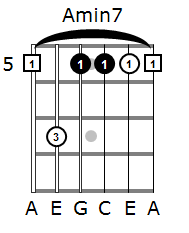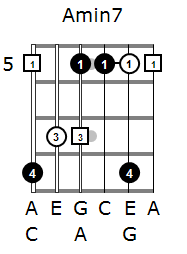Improve your pentatonic solos with arpeggios
Arpeggios are like scales, but with fewer notes, and are based on specific chords. If you’ve just started trying to improvise your own guitar solos, you should probably hold off on learning arpeggios and keep working on pentatonic scales. On the other hand, if you’ve gotten bored with the pentatonic scales, then learning what arpeggios are and how to use them are a great way to spice up your playing.
Basic Concepts of Arpeggios
When you play an Amin7 chord, you’re playing at least four notes – A, C, E, and G.

In this case, you’re playing the A and E notes twice, but what you need to remember is that the chord consists of A, C, E, and G. To make an arpeggio from this chord, you have to look at the four or five frets around this chord, and find all instances of of those 4 notes, and then figure out a logical fingering to play the arpeggio. In this case, you’d play the arpeggio as follows:
 . . . and in tablature and standard notation . . .
. . . and in tablature and standard notation . . .

There are two things you should take note of. When you play the C note on the third string, and then the E note on the second string, you’ll need to lay your index finger across both strings. On the way back up the strings, you’ll have to think ahead and lay the finger across both the second and third strings. Also, if you’re familiar with your pentatonic scales, you may have noticed this arpeggio looks a lot like the minor pentatonic scale. That’s why I started with this one. This arpeggio is good for beginners to learn because it’s almost identical to the minor pentatonic scale. In fact, it basically IS the minor pentatonic scale, minus one note. If you added a D note, it would be an A minor pentatonic scale.
How to use arpeggios in solos
The best use for arpeggios are when you’re trying to solo over a set of chord changes that don’t fit nicely into one key. This doesn’t happen that often in rock music, but once in a while you’ll run into songs that throw this curveball at you. For example, the chords in Santeria by Sublime are Emaj, G#maj, C#min, and Bmaj. That chord progression is in the key of Emaj for the most part, but that G#maj chord doesn’t fit – in the key of Emaj, you’d have a G#min chord instead. Because of that G#maj chord, you can’t happily wail away with a flurry of string bending pentatonic riffs, and instead have to throw a G#maj arpeggio in the middle of your otherwise easy pentatonic scale solo. Think that’s tough? Jazz players have it about ten times worse with the tunes they improvise over.
You can use this minor 7 arpeggio in the same place you would use your minor pentatonic scale, and just approach it as a different riff to throw into the mix. The hardest thing about playing arpeggios for beginners is playing one note on a string and then having to move to the next string. When you play pentatonic scales, you always play two notes per string, which is easier for the picking hand. Playing variations of one and two notes per string breaks your rhythm and is more difficult.
For further study . . .
You can form an arpeggio for any chord you play that has three notes or more. If you want to try learning more, you should work on learning the arpeggios for dominant 7 chords. For rock and blues, the minor 7 and dominant 7 arpeggios are going to be the most useful ones to know, and the easiest ones to incorporate into rock and blues solos.